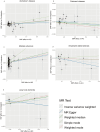Causal associations and shared genetic etiology between neurodegenerative diseases and constipation
- PMID: 40727259
- PMCID: PMC12301607
- DOI: 10.1177/25424823251362469
Causal associations and shared genetic etiology between neurodegenerative diseases and constipation
Abstract
Background: There is increasing evidence suggesting a correlation between neurodegenerative diseases (NDDs) and constipation; however, their genetic relationship and causal mechanisms remain inadequately elucidated.
Objective: We aim to investigate the causal link and shared genetic basis between NDDs and constipation.
Methods: We obtained summary statistics from large-scale genome-wide association studies, encompassing five NDDs, including Alzheimer's disease (AD), Parkinson's disease (PD), multiple sclerosis (MS), amyotrophic lateral sclerosis (ALS), Lewy body dementia (LBD), as well as constipation. The primary analysis employed five Mendelian randomization methods to evaluate causal effects, while linkage disequilibrium score regression (LDSC) and high-definition likelihood (HDL) were utilized to investigate genetic correlations. Additionally, significant pleiotropic SNPs were identified using pleiotropic analysis under the composite null hypothesis (PLACO) and functional mapping and annotation (FUMA). Finally, enrichment analysis was conducted to explore the biological pathways associated with the identified pleiotropic genes.
Results: MR analysis revealed a significant causal relationship between AD and an enhanced risk of constipation was demonstrated (OR = 1.043, 95% CI: 1.015-1.073, p = 0.003), while no causality was found between PD, MS, ALS, LBD, and the risk of constipation (p > 0.05). LDSC and HDL analysis revealed a significant positive genetic correlation between AD and constipation. Using PLACO combined with FUMA, we identified 30 overlapping pleiotropic loci, with pathway enrichment analysis revealing important biological pathways related to Aβ metabolism and processing, tau protein process, and the complement and coagulation cascades.
Conclusions: Our study indicates that AD is a contributing factor to constipation and uncovers the complex genetic mechanisms linking AD and constipation, which holds significant implications for diagnosis and treatment of both conditions.
Keywords: Alzheimer's disease; Mendelian; causal associations; constipation.
© The Author(s) 2025.
Conflict of interest statement
The authors declared no potential conflicts of interest with respect to the research, authorship, and/or publication of this article.
Figures







References
-
- Knudsen K, Krogh K, Østergaard K, et al. Constipation in Parkinson's disease: subjective symptoms, objective markers, and new perspectives. Mov Disord 2017; 32: 94–105. - PubMed
-
- Pellegrini C, Antonioli L, Colucci R, et al. Interplay among gut microbiota, intestinal mucosal barrier and enteric neuro-immune system: a common path to neurodegenerative diseases? Acta Neuropathol 2018; 136: 345–361. - PubMed
-
- Hansson O. Biomarkers for neurodegenerative diseases. Nat Med 2021; 27: 954–963. - PubMed
LinkOut - more resources
Full Text Sources
Miscellaneous

